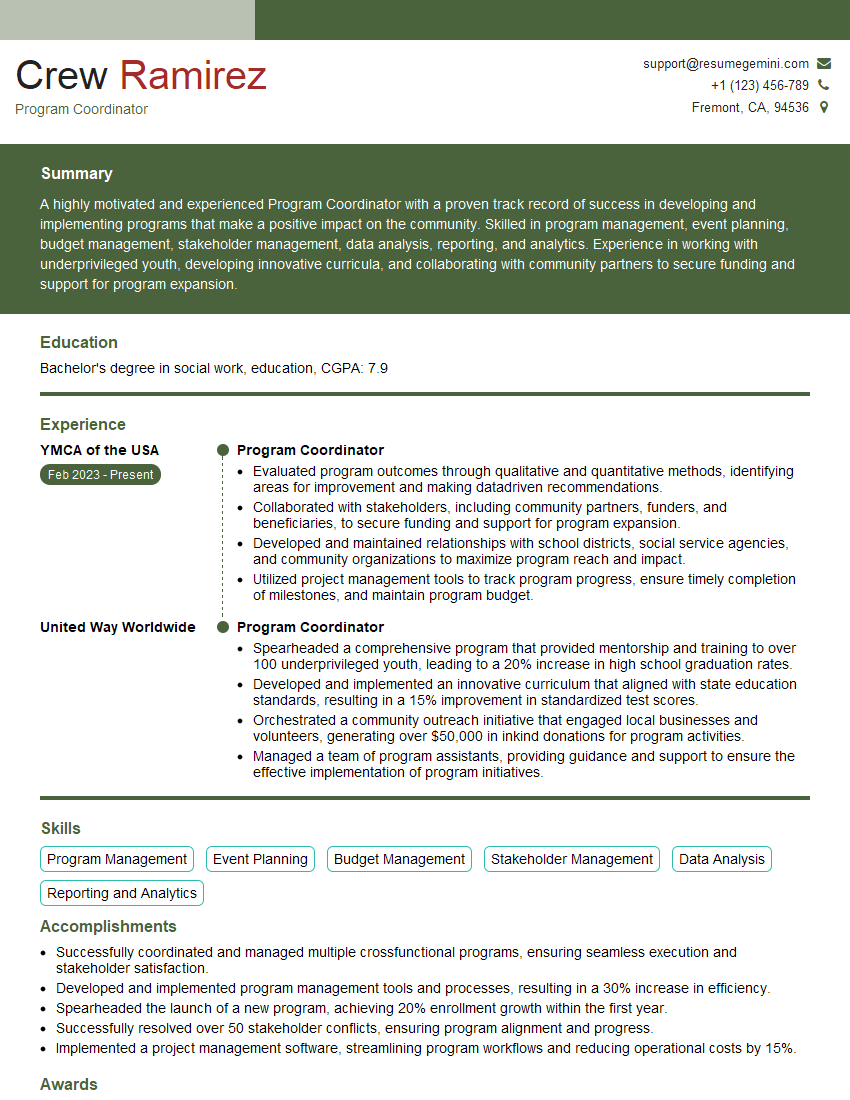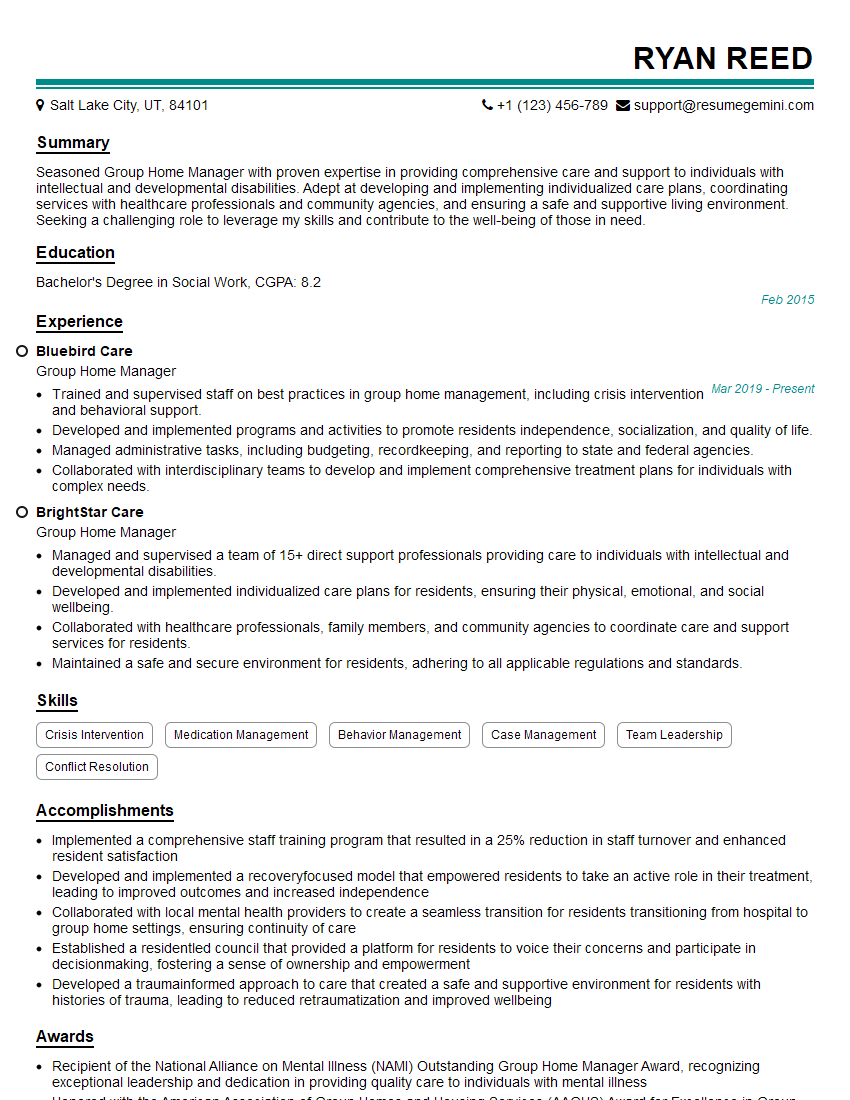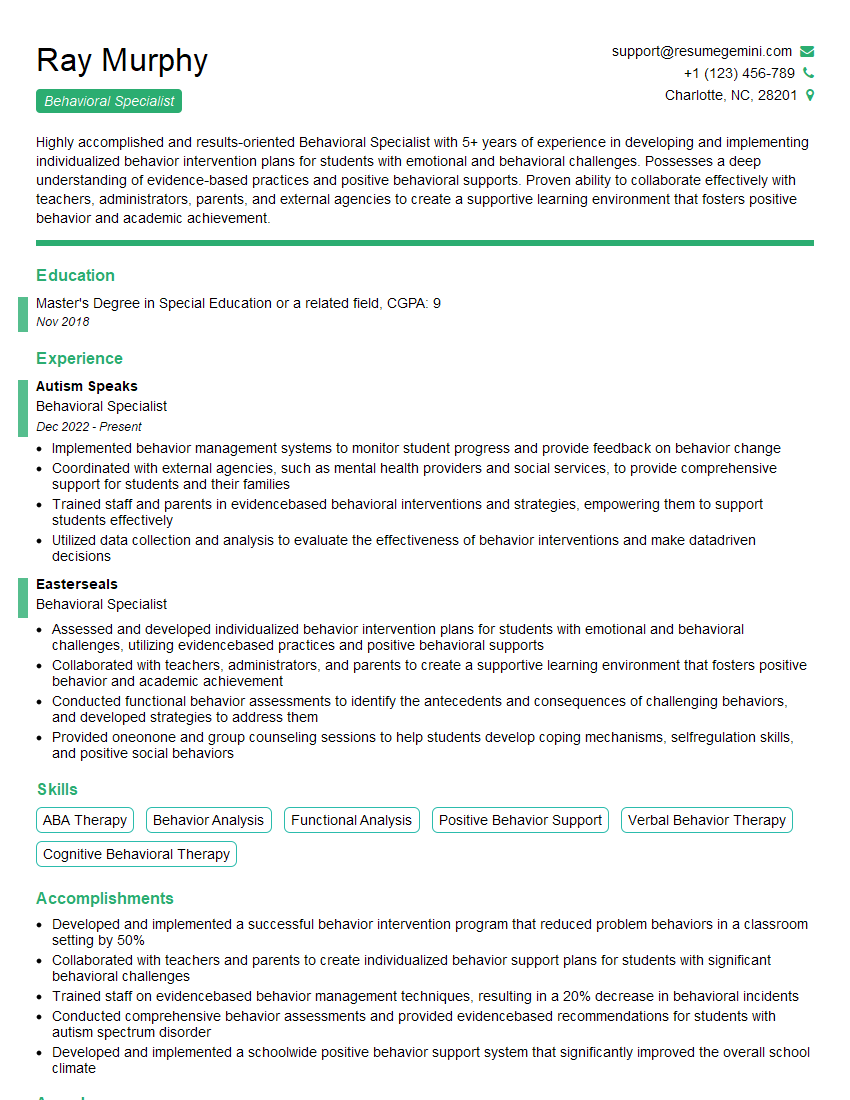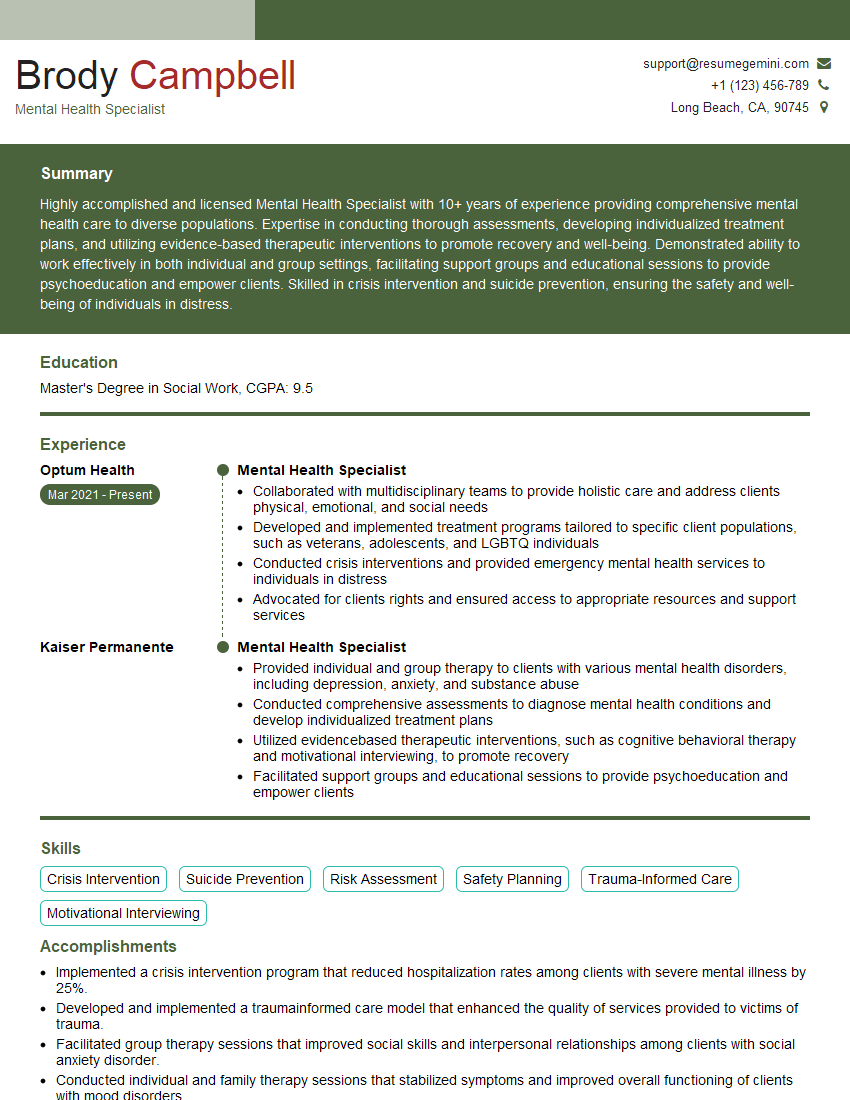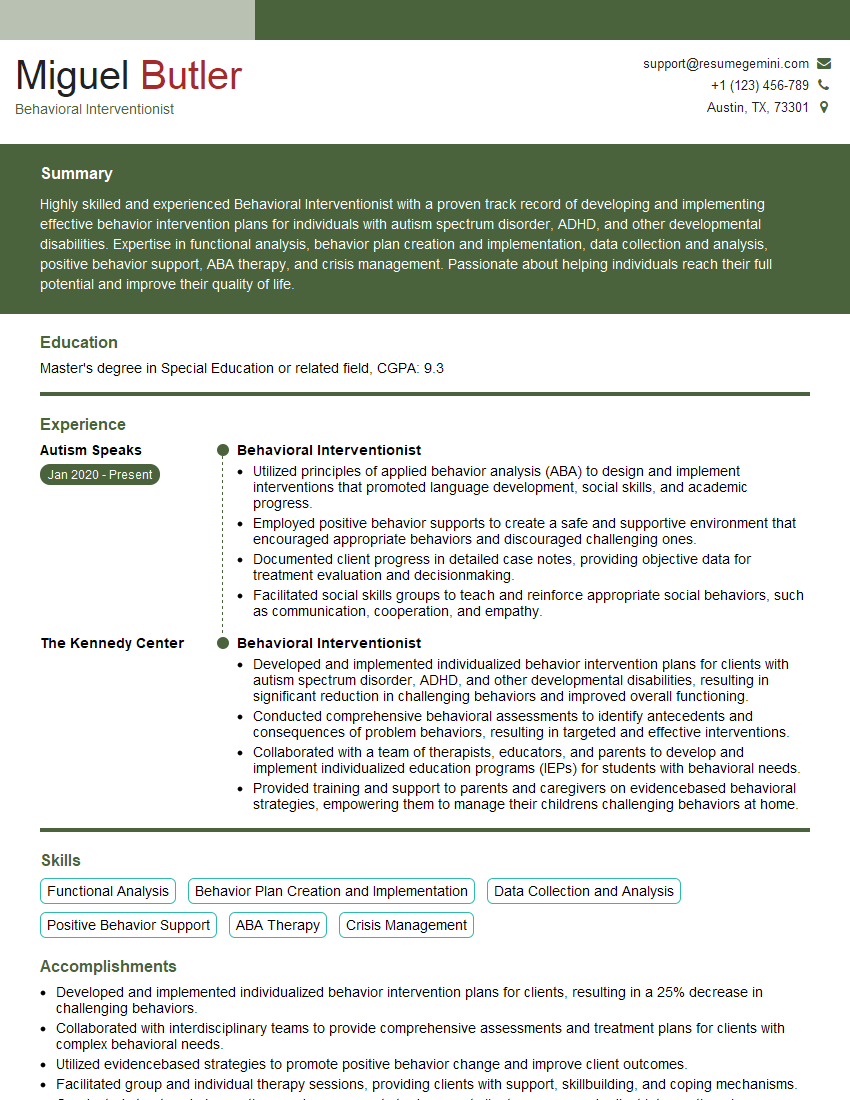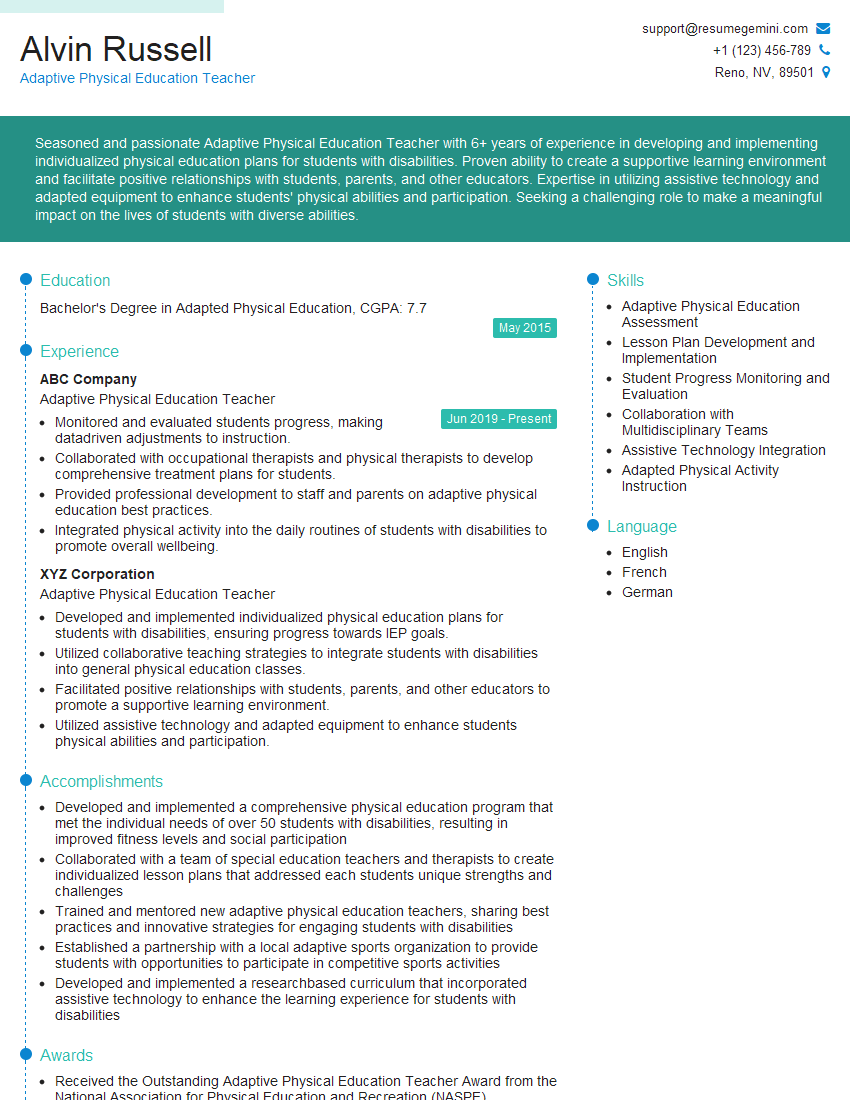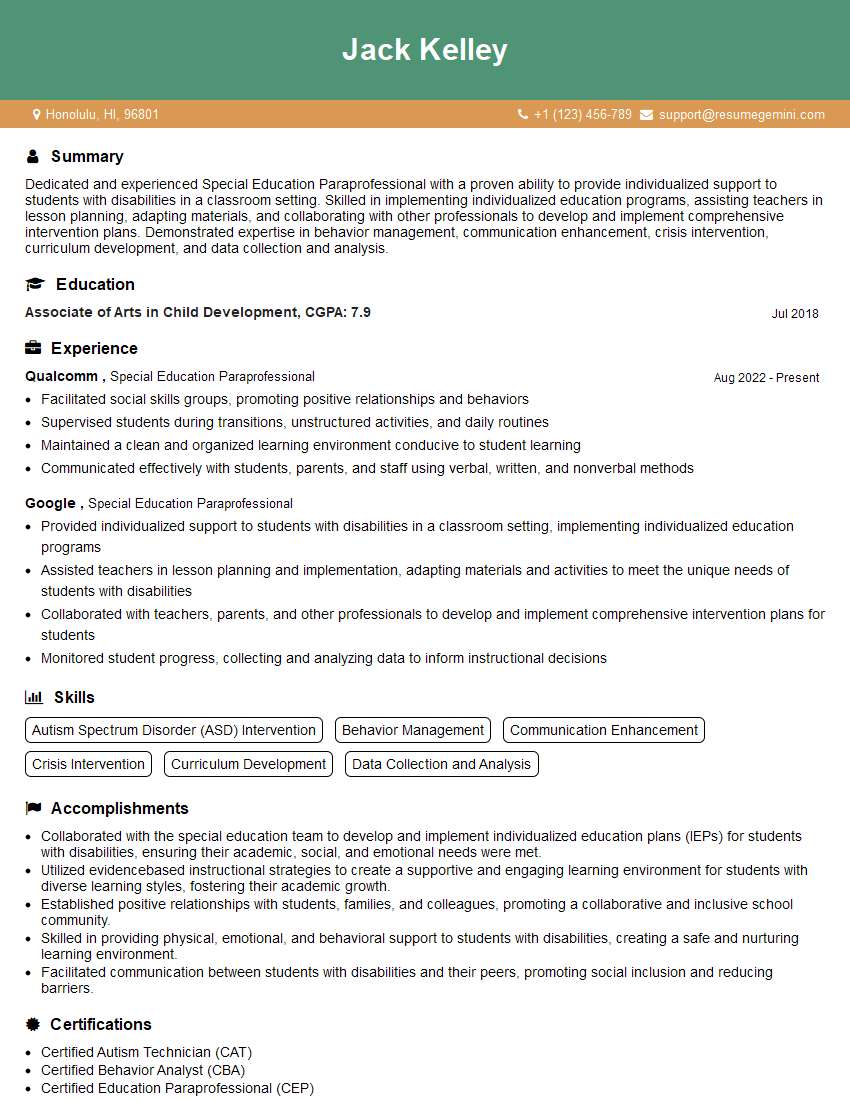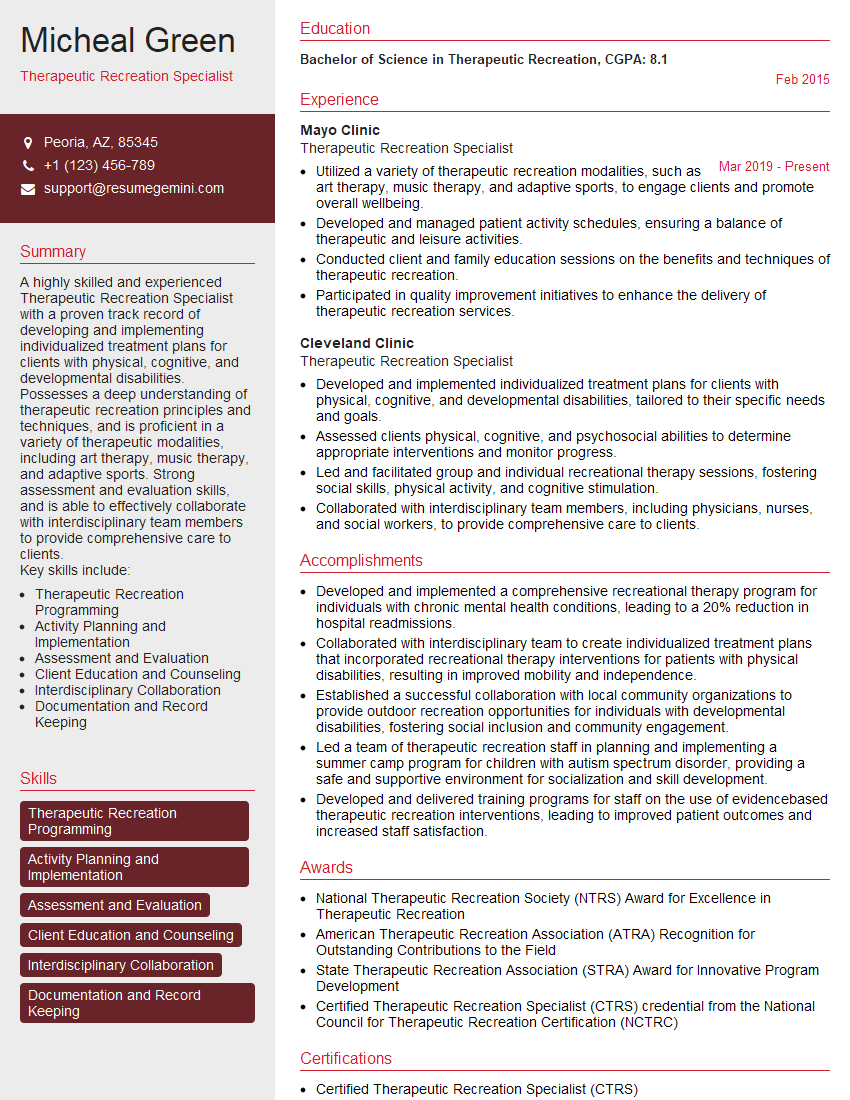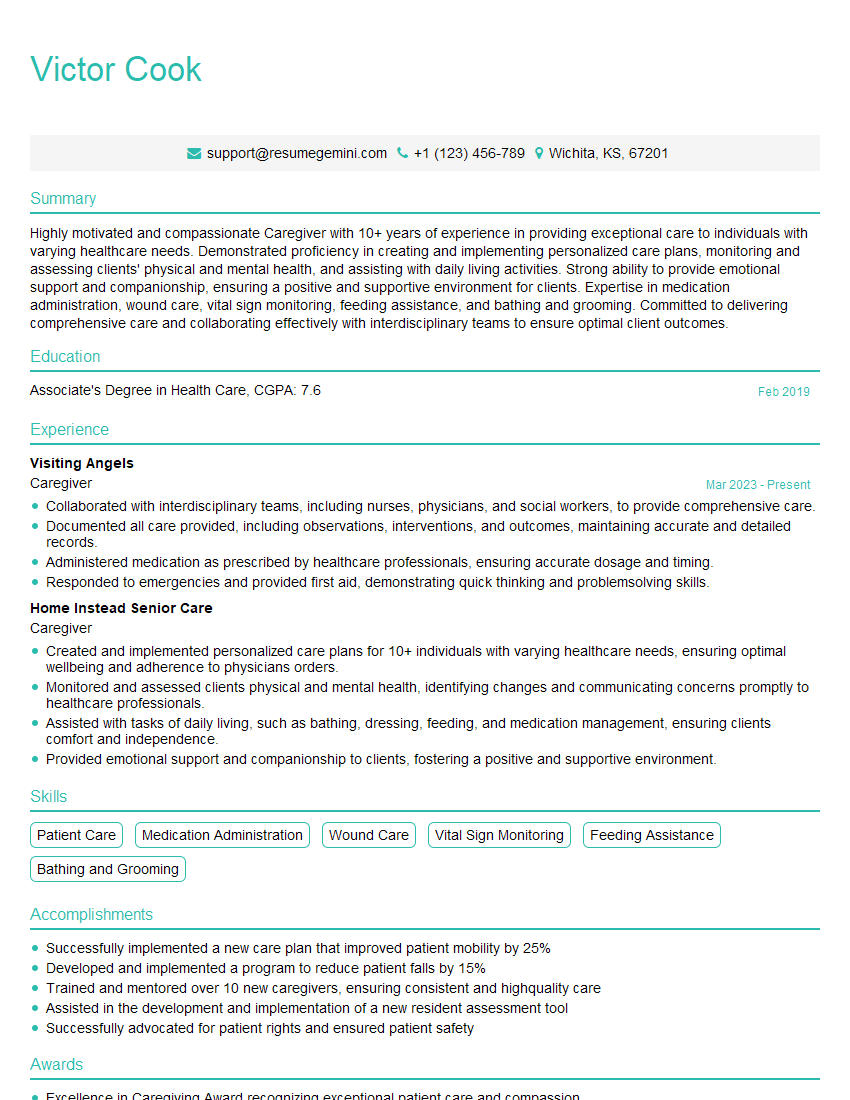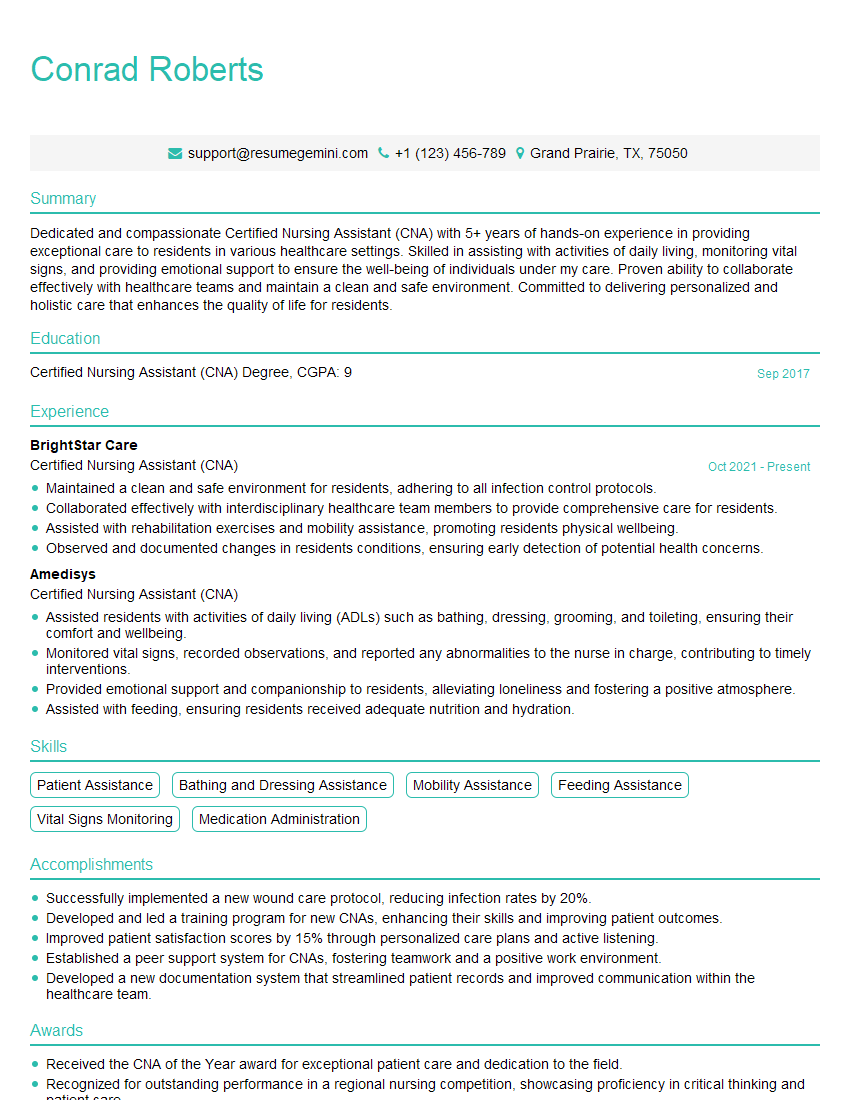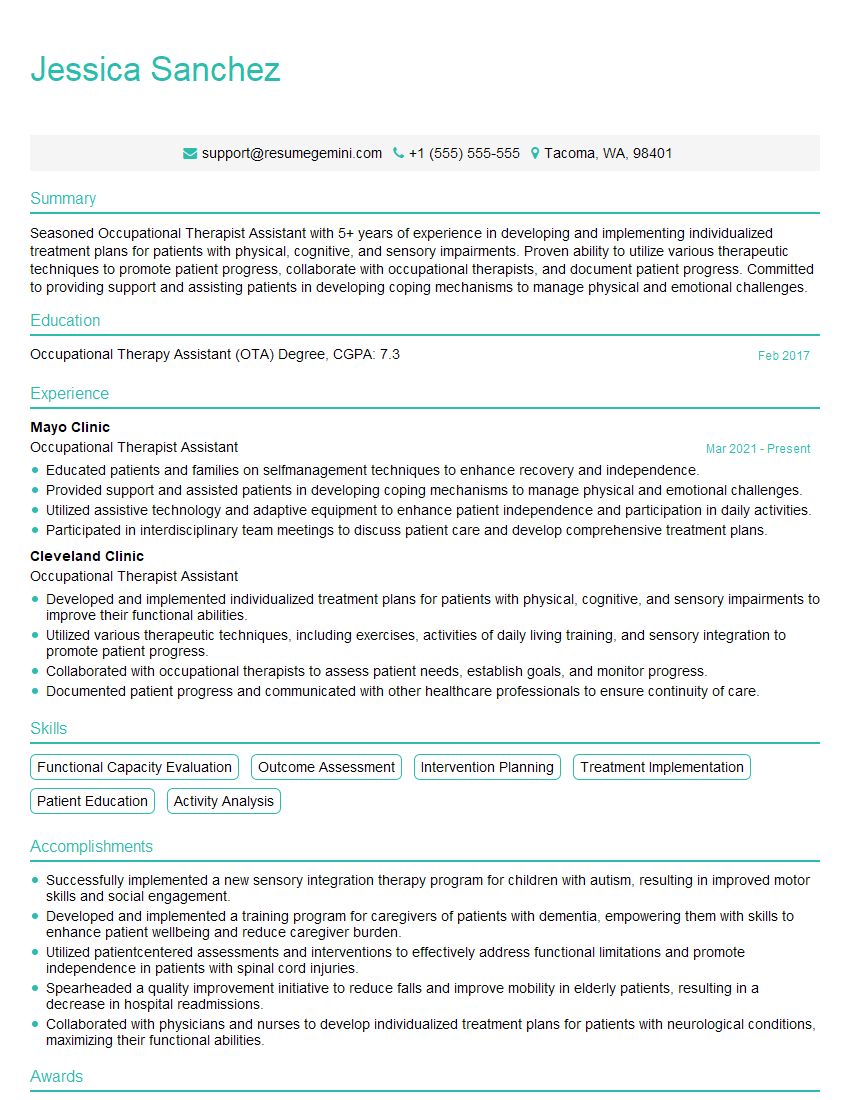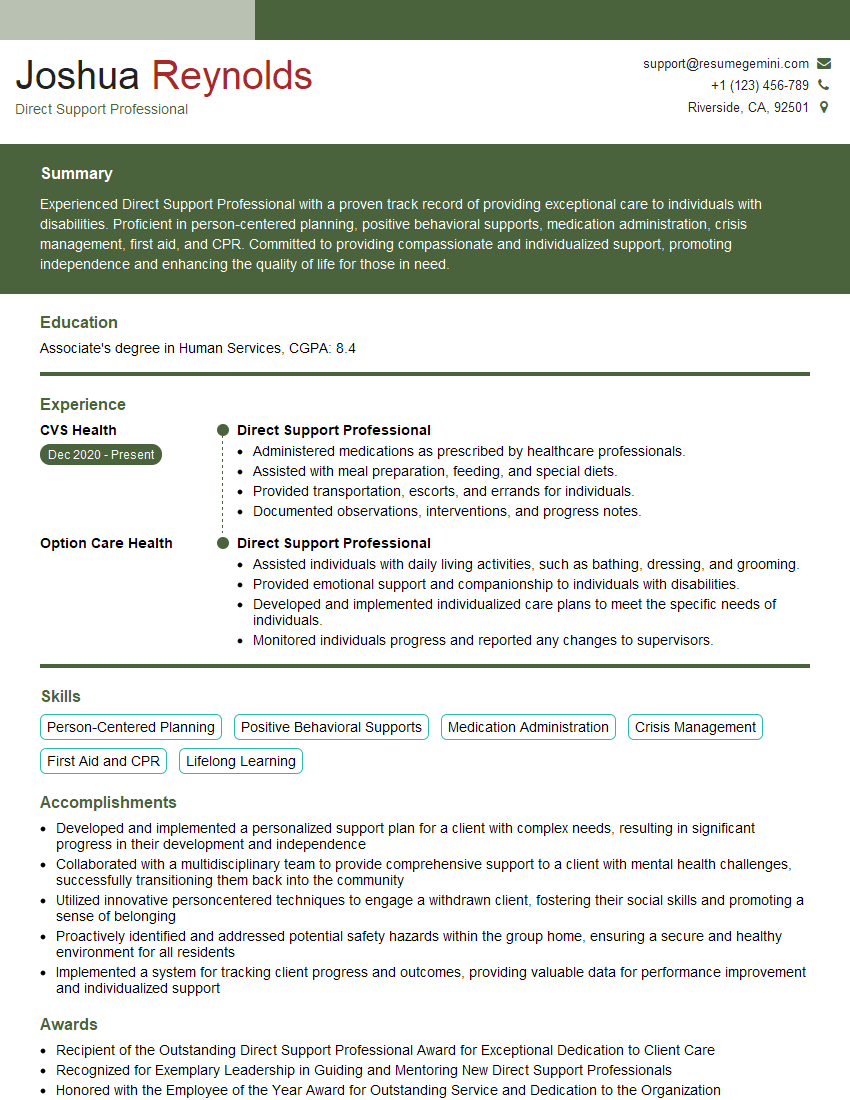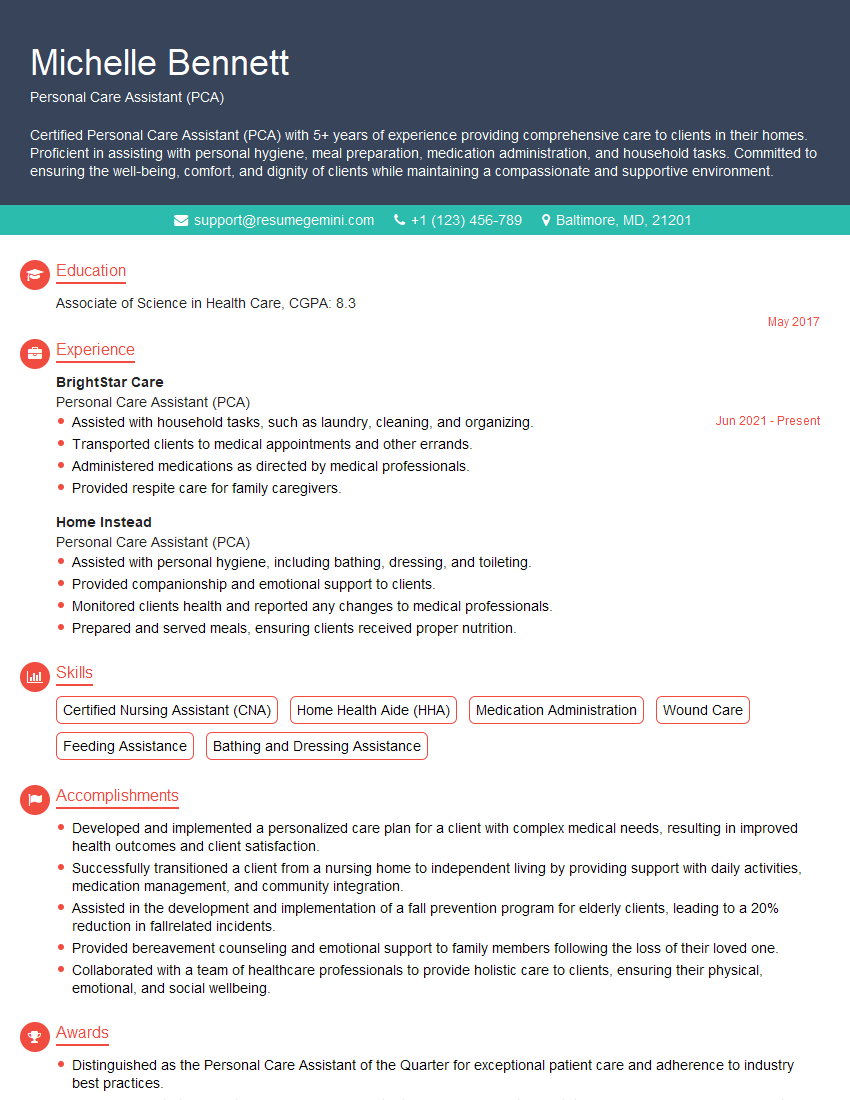The right preparation can turn an interview into an opportunity to showcase your expertise. This guide to Toileting and Hygiene Skills for Students with Mental Handicaps interview questions is your ultimate resource, providing key insights and tips to help you ace your responses and stand out as a top candidate.
Questions Asked in Toileting and Hygiene Skills for Students with Mental Handicaps Interview
Q 1. Describe your experience in teaching toileting skills to students with intellectual disabilities.
My experience teaching toileting skills to students with intellectual disabilities spans over ten years. I’ve worked with a diverse range of students, from those with mild intellectual disabilities who require minimal support to those with more significant challenges requiring intensive, individualized instruction. My approach always begins with a thorough assessment of the student’s current abilities and limitations, including their physical capabilities, cognitive understanding, and communication skills. I then develop a personalized plan that incorporates positive reinforcement, visual aids, and consistent routines. For instance, I worked with a young man who had difficulty understanding verbal instructions. We used a picture schedule showing each step of the toileting process – from washing hands to flushing the toilet. This visual support significantly improved his independence.
I also focus on building the student’s self-esteem and confidence. Celebrating small successes and providing consistent praise are key elements of my teaching methodology. The process is gradual and requires patience; setbacks are expected, and I emphasize adapting the approach based on the student’s progress and individual needs. A key part of my success is strong collaboration with parents and other support staff to ensure consistency across all environments.
Q 2. What are some common challenges encountered when teaching hygiene skills to students with mental handicaps?
Teaching hygiene skills to students with mental handicaps presents several unique challenges. Cognitive limitations can make understanding and remembering instructions difficult. Some students may struggle with abstract concepts like germs and hygiene’s importance. Physical limitations, such as limited motor skills or sensory sensitivities, can also pose obstacles. For example, a student with low muscle tone might find it hard to manipulate clothing fasteners or wipe themselves effectively. Behavioral challenges, such as anxiety, oppositional behavior, or sensory aversions to water or certain textures, frequently complicate the learning process. Finally, communication difficulties can make it challenging to assess a student’s understanding and provide effective feedback. A student who cannot communicate their need to use the restroom, for instance, might experience accidents.
Q 3. Explain different strategies for managing incontinence in students with intellectual disabilities.
Managing incontinence in students with intellectual disabilities requires a multi-faceted approach. Behavioral strategies, such as establishing regular toileting schedules, using prompts (visual or verbal reminders), and rewarding successful toileting attempts, are crucial. Medical interventions may be necessary in some cases, such as medication to manage underlying medical conditions contributing to incontinence. Adaptive equipment, like absorbent undergarments or specialized toilet seats, can provide comfort and prevent accidents. Fluid management is also important; limiting fluid intake before bedtime, for instance, can reduce nighttime accidents. Finally, bladder training programs, involving gradual increases in the time between toileting, can help improve bladder control. It’s vital to remember that a holistic approach, combining behavioral, medical, and adaptive strategies, often yields the best results.
Q 4. How do you adapt toileting and hygiene routines to meet the individual needs of students with diverse disabilities?
Adapting toileting and hygiene routines involves careful consideration of each student’s unique needs. For students with physical disabilities, adaptations might include using adaptive equipment like grab bars, raised toilet seats, or modified faucets. For students with sensory sensitivities, routines might be adjusted to minimize sensory overload. For example, a student with aversion to loud noises might benefit from a quieter hand-washing environment. Students with cognitive limitations benefit from simplified instructions, visual supports, and consistent routines. Students with autism spectrum disorder often respond well to structured and predictable routines, with clear visual cues and consistent verbal prompts. The key is flexibility and a willingness to tailor the approach to best meet each individual’s strengths and challenges, always involving the student and their family in decision-making.
Q 5. What are the appropriate methods for communicating hygiene procedures to students with varying communication abilities?
Communicating hygiene procedures effectively depends heavily on the student’s communication abilities. For students with verbal communication skills, clear, concise, and age-appropriate instructions are important. For students with limited verbal skills, visual aids such as picture cards, videos, or social stories are invaluable. Augmentative and alternative communication (AAC) systems, such as picture exchange systems (PECS) or speech-generating devices, can also significantly improve communication. Non-verbal communication, such as gestures and modeling, is crucial for all students. It’s vital to observe each student’s response to different methods and adjust your approach accordingly. Consistency is key; using the same methods consistently across different settings ensures better comprehension and reduces confusion.
Q 6. How do you reinforce positive hygiene behaviors in students?
Reinforcing positive hygiene behaviors involves employing a variety of strategies based on principles of applied behavior analysis (ABA). Positive reinforcement, such as verbal praise, stickers, small rewards, or privileges, immediately following a successful toileting or hygiene action, is highly effective. Token economies, where students earn tokens for positive behaviors and later exchange them for desired items or activities, can also be beneficial. Modeling appropriate behaviors allows students to observe and imitate correct techniques. Prompting, which involves providing cues or assistance to guide the student, can be phased out gradually as their independence grows. Consistency and patience are crucial for successful reinforcement. Celebrating even small successes helps build confidence and motivates students to continue practicing positive hygiene habits.
Q 7. Describe your experience with using visual aids and assistive devices to support toileting and hygiene training.
Visual aids and assistive devices are indispensable tools in toileting and hygiene training. Visual schedules, using pictures or symbols to depict each step in the process, are highly effective in teaching sequences of actions. Social stories, short narratives describing social situations and appropriate behaviors, help students understand expectations and reduce anxiety. Assistive devices such as grab bars, raised toilet seats, bidet attachments, and adaptive clothing fasteners enhance independence and safety. Interactive apps and digital tools can also be incorporated to make the learning process more engaging and fun. For example, I used a simple app with interactive animations to teach a student with autism the steps of handwashing. The positive reinforcement within the app boosted his participation and success. Selecting and implementing the appropriate tools requires careful assessment of the student’s individual needs and preferences.
Q 8. How do you address accidents and setbacks during toileting and hygiene training?
Accidents and setbacks are a normal part of the toileting and hygiene training process, especially for students with mental handicaps. It’s crucial to approach these situations with patience, understanding, and a positive reinforcement approach. We avoid using punishment, as this can be counterproductive and increase anxiety around toileting.
My approach involves:
- Calmly addressing the situation: I remain calm and reassuring, helping the student clean up without judgment or shame. This creates a safe and supportive environment.
- Analyzing the cause: We investigate potential contributing factors like missed cues, distractions, or physical limitations. This helps us adapt the training plan.
- Adjusting the training plan: Based on the analysis, adjustments might include more frequent bathroom breaks, visual cues, or changes to the training schedule. For example, if a student is having accidents due to difficulty with clothing fasteners, we might explore adaptive clothing options.
- Positive reinforcement: Even with setbacks, I emphasize positive reinforcement. Successfully using the toilet, even inconsistently, is celebrated with praise and rewards to maintain motivation.
- Documentation: Each incident, along with our response and any adjustments made, are meticulously documented to track progress and inform future strategies. This data is invaluable in understanding patterns and predicting potential issues.
For example, if a student consistently has accidents in the afternoon, we might explore if fatigue is a factor and adjust the timing of bathroom breaks.
Q 9. What safety precautions do you take to ensure student safety during toileting and hygiene routines?
Student safety is paramount. Our toileting and hygiene routines prioritize safety at every step. We employ several strategies:
- Non-slip mats: Bathrooms are equipped with non-slip mats to prevent falls.
- Grab bars and other assistive devices: Grab bars and other assistive devices are strategically placed to aid mobility and provide stability, especially for students with motor challenges.
- Proper water temperature monitoring: Hot water temperatures are carefully monitored to prevent burns. Thermometers are regularly used to check the water temperature.
- Supervision: Appropriate levels of supervision are always provided, tailored to the individual student’s needs and abilities. This varies from close supervision to more independent toileting with occasional checks.
- Emergency procedures: Clear emergency procedures are in place to handle accidents or unexpected medical events. Staff are trained on how to respond appropriately and efficiently.
- Safe storage of hygiene products: All cleaning products and hygiene items are stored securely and out of reach of students.
For instance, if a student has a history of seizures, we might adapt the bathroom environment with padded surfaces and implement additional safety measures during toileting.
Q 10. Explain your understanding of dignity and respect in providing personal care to students with mental handicaps.
Dignity and respect are fundamental to providing personal care. We treat each student as an individual with inherent worth, regardless of their abilities or challenges. This means:
- Privacy and modesty: We always ensure privacy and modesty, providing opportunities for students to participate as much as they are able in maintaining their hygiene, and respecting their personal space.
- Respectful communication: We use respectful and appropriate language, avoiding infantilising or patronising terms. We encourage and support independence as much as possible.
- Choice and autonomy: Where possible, we provide choices to foster a sense of control. For example, choosing between different soaps or towels.
- Empowerment: We focus on empowering students to take as much responsibility for their hygiene as possible. We celebrate successes, no matter how small.
- Professional boundaries: We maintain professional boundaries while demonstrating warmth and empathy. We ensure all interactions are appropriate and respectful.
For example, if a student is struggling with dressing, I might provide assistance while encouraging them to participate as much as they are comfortable with, verbally praising their effort.
Q 11. How do you handle challenging behaviors that may interfere with toileting and hygiene practices?
Challenging behaviors can significantly impact toileting and hygiene routines. A proactive, individualized approach is crucial.
My strategy involves:
- Functional Behavior Assessment (FBA): Conducting an FBA helps identify the triggers, function, and consequences of the behavior. This provides valuable insights into addressing the underlying cause, not just the symptom.
- Positive Behavior Support (PBS): Implementing a PBS plan focuses on teaching replacement behaviors and reinforcing positive actions. This is more effective than simply punishing unwanted behaviors.
- Environmental modifications: Adjusting the physical environment to reduce triggers can be very helpful. This might involve using visual schedules, reducing distractions, or modifying bathroom layouts.
- Collaboration with specialists: Working with occupational therapists, behavior analysts, and other specialists provides a multidisciplinary approach that can create a comprehensive support system.
- De-escalation techniques: Training staff in de-escalation techniques is crucial for managing challenging behaviors effectively and safely.
For instance, if a student becomes agitated during dressing, we might implement a visual schedule to show the steps involved, use calming techniques, and offer rewards for cooperation.
Q 12. How do you collaborate with parents and other professionals regarding a student’s toileting and hygiene progress?
Collaboration with parents and other professionals is essential for successful toileting and hygiene training. Regular communication ensures a consistent approach across all settings.
My approach:
- Regular meetings: I schedule regular meetings with parents to discuss progress, challenges, and strategies. These meetings provide a forum for sharing information and collaboratively developing plans.
- Open communication: Maintain open and consistent communication through phone calls, emails, and progress reports. This ensures everyone is informed and involved.
- Shared documentation: Using a shared online platform or other method for documentation ensures everyone has access to the same information, facilitating consistent care.
- Team meetings: Participating in team meetings with other professionals involved in the student’s care, like therapists and medical personnel, ensures a coordinated approach and shared understanding.
- Parent training: Providing parent training on effective techniques and strategies helps them support the student’s progress at home.
For example, I might collaborate with an occupational therapist to adapt bathroom equipment to improve a student’s independence in toileting.
Q 13. How do you document and track a student’s progress in toileting and hygiene skills?
Progress is meticulously documented using a variety of methods to track the student’s development and inform our approach.
Documentation methods:
- Data sheets: Detailed data sheets record the frequency of accidents, successful toileting attempts, and any observations related to the student’s toileting behavior. These sheets include details such as time of day, type of accident, and any interventions used.
- Anecdotal records: Anecdotal records provide rich qualitative data on the student’s progress, capturing insights into their behavior, motivation, and challenges.
- Progress reports: Regular progress reports summarize the student’s development, highlighting successes, challenges, and future goals. These reports are shared with parents and other professionals.
- Photographs and videos (with parental consent): Visual documentation can be very helpful in tracking progress, particularly for students with communication challenges.
- Digital platforms: Using digital platforms for documentation allows for easy sharing and collaborative access to data, simplifying communication and enhancing teamwork.
For example, a data sheet might track the number of dry periods throughout the day, the student’s level of prompting required, and any changes in routines that correlate with toileting success.
Q 14. Describe your experience with different types of incontinence products and their appropriate use.
My experience encompasses a range of incontinence products, each with its appropriate application:
- Diapers/Absorbent Underwear: These are commonly used for students with significant incontinence. Different absorbency levels cater to varying needs. Proper sizing is essential for comfort and effectiveness.
- Pull-ups: These offer a compromise between diapers and underwear, providing some independence while still offering absorbency. They’re often a transitional tool in training.
- Protective Underwear: This provides a higher level of discretion than traditional diapers, appearing like regular underwear. Suitable for students experiencing occasional accidents or lighter incontinence.
- Pads and Liners: These can supplement other products or provide protection during light incontinence, particularly for bladder control issues.
- Catheters and other medical devices (in collaboration with medical professionals): In certain medical situations, catheters or other medical devices might be necessary. The use of these is always in consultation with and under the guidance of appropriate medical professionals.
Choosing the appropriate product depends on the student’s specific needs, including the severity and frequency of incontinence, mobility level, and personal preferences. We prioritize products that ensure both functionality and comfort, minimizing discomfort and maximizing dignity.
Q 15. How do you assess a student’s readiness for toileting and hygiene training?
Assessing a student’s readiness for toileting and hygiene training requires a holistic approach, considering their physical, cognitive, and emotional capabilities. It’s not a one-size-fits-all process. We start by observing their current skills. Can they communicate their needs? Do they demonstrate any awareness of being wet or soiled? Do they have the physical dexterity to manage clothing? We also assess their understanding of cause and effect – do they connect the feeling of needing to go with the act of using the toilet?
We use standardized assessment tools, and create individualized checklists based on the student’s specific needs. For example, we might track bowel and bladder patterns, note any signs of discomfort, and document their attempts at self-toileting. This data helps us establish a baseline and tailor an individualized education plan (IEP).
Consider a student who consistently fidgets and pulls at their pants. This could signal readiness to communicate the need to use the toilet. On the other hand, a student who shows no awareness of being wet or soiled may need more time before commencing formal training. The key is patient observation and individualized assessment.
Career Expert Tips:
- Ace those interviews! Prepare effectively by reviewing the Top 50 Most Common Interview Questions on ResumeGemini.
- Navigate your job search with confidence! Explore a wide range of Career Tips on ResumeGemini. Learn about common challenges and recommendations to overcome them.
- Craft the perfect resume! Master the Art of Resume Writing with ResumeGemini’s guide. Showcase your unique qualifications and achievements effectively.
- Don’t miss out on holiday savings! Build your dream resume with ResumeGemini’s ATS optimized templates.
Q 16. What are some appropriate methods for motivating students to participate in toileting and hygiene routines?
Motivation is crucial. We use positive reinforcement techniques consistently. We avoid punishment, instead focusing on rewarding progress, however small. A reward system might involve using a sticker chart, offering small privileges (extra playtime, a preferred activity), or providing verbal praise and encouragement. We tailor the rewards to the student’s individual preferences.
Visual aids, such as picture schedules showing the steps involved in toileting, can be incredibly effective. These make the process more predictable and reduce anxiety. We also involve the student in choosing their rewards and actively celebrate their achievements to make the experience positive and engaging. Think of it like a game – we’re guiding them toward success with rewards and positive feedback.
For instance, a student who successfully uses the toilet independently might earn a special treat or get to choose a book to read. This makes the process enjoyable and less of a chore.
Q 17. How do you create a positive and supportive learning environment for toileting and hygiene training?
A positive and supportive learning environment is paramount. The space should be safe, comfortable, and predictable. We use consistent routines and clear communication. We ensure the student feels secure and respected. Privacy is crucial, so we respect their personal space and only assist when necessary.
We incorporate patience and understanding into every interaction, acknowledging that accidents happen and that progress may be slow. We focus on celebrating small wins and offering encouragement instead of criticism. We also involve parents or caregivers in the process to ensure consistency across different settings. This creates a sense of teamwork and support. Think of creating a ‘safe haven’ where learning feels comfortable.
For example, we might establish a designated toileting area with familiar visual cues and calming elements, minimizing distractions to create a relaxed atmosphere for the student.
Q 18. What are some common signs of hygiene-related issues that require further intervention?
Several signs may indicate hygiene-related issues requiring further intervention. These include consistent soiling or wetting, skin irritation or rashes (possibly from prolonged exposure to urine or feces), unpleasant body odor, difficulty with personal hygiene tasks (like handwashing or brushing teeth), and social withdrawal related to hygiene concerns.
A student who consistently smells of urine or feces, despite being changed regularly, might have a medical condition requiring medical attention. Similarly, persistent skin irritation could signal an allergic reaction or infection. We carefully observe these signs and immediately consult with parents, caregivers, or medical professionals when necessary.
For example, if a student displays persistent skin rashes, we would immediately report this to their parents and suggest a consultation with a dermatologist to rule out any underlying medical issues.
Q 19. How do you handle situations where a student refuses to participate in hygiene routines?
Handling refusal requires patience, understanding, and a collaborative approach. We first try to understand the underlying reason for the refusal. Is the student experiencing anxiety, discomfort, or perhaps lack of understanding? We carefully observe their behaviour and communication (verbal or nonverbal) to determine the cause. It’s crucial to avoid power struggles.
We might use positive reinforcement strategies, offering choices within the routine, and providing opportunities for the student to participate actively in the process. We might also involve the student in the selection of hygiene products or routines. If the refusal persists, we involve the parents and relevant healthcare professionals to identify underlying medical or behavioral issues. Sometimes a referral to a therapist or other specialist may be helpful.
For example, a student who resists handwashing might be given a choice of soaps or be allowed to participate in choosing their towel. We’d try to make the process fun and less of a forced activity.
Q 20. What are your strategies for teaching students about appropriate hygiene practices in various settings (e.g., school, home)?
Teaching hygiene practices across different settings requires consistency and generalization of skills. We use visual aids, role-playing, and social stories to teach appropriate behaviors in various environments like school, home, and community settings. We emphasize the importance of hygiene in preventing illness and maintaining personal health. We create clear expectations and make sure the student understands the routines and why they are important. The routines should be consistent in all settings.
For example, we might use role-playing to practice handwashing techniques in a pretend classroom or restaurant setting. We might also create visual schedules or checklists to remind the student of the steps involved in maintaining hygiene. We’d consistently reinforce the learned behavior in all environments.
Consistent messaging across home and school is crucial. Regular communication between parents and school staff is important to ensure the student’s consistent practice of hygiene skills in both environments.
Q 21. How do you ensure the confidentiality and privacy of students during personal care routines?
Confidentiality and privacy are paramount. We ensure all personal care routines are conducted with sensitivity and respect for the student’s dignity. We respect their personal space and only assist when absolutely necessary, always ensuring we minimize exposure. We communicate clearly with students about what we are doing and why. We also carefully follow relevant privacy policies and regulations.
We educate all staff members about appropriate behavior and emphasize the importance of maintaining confidentiality. We use screens or other privacy measures whenever possible. We ensure that students have a voice in determining who assists them with personal care routines whenever appropriate.
For example, we would ensure that doors are closed during toileting assistance and that only necessary staff members are present. We would always use a polite and respectful approach, explaining each step of the routine in clear and simple terms.
Q 22. Describe your experience with modifying the physical environment to support toileting and hygiene independence.
Modifying the physical environment is crucial for promoting toileting and hygiene independence in students with mental handicaps. This involves making the bathroom and surrounding areas accessible and user-friendly. It’s about designing a space that minimizes challenges and maximizes their ability to perform these tasks independently.
Adaptive Equipment: Installing grab bars, raised toilet seats, and adjustable showerheads are essential for safety and ease of use. For example, a student with mobility challenges might benefit greatly from a raised toilet seat and grab bars to prevent falls.
Clear Signage and Visual Cues: Using pictures or symbols to label sinks, toilets, and soap dispensers can significantly improve understanding and reduce confusion, particularly for students with cognitive impairments. We might use a simple picture of hands being washed next to the soap dispenser.
Space Optimization: Ensuring ample space for wheelchairs and other mobility aids is vital. A cramped bathroom can create anxiety and hinder independence. For instance, enough space to maneuver a wheelchair to the toilet and sink is crucial.
Sensory Considerations: Reducing distractions like loud noises or bright lights can be beneficial for students with sensory sensitivities. A calming environment encourages relaxation and eases the process.
Q 23. How do you teach students with visual impairments about proper hygiene practices?
Teaching hygiene to visually impaired students requires a multi-sensory approach. We focus on tactile learning and clear verbal instructions. It’s about creating a learning experience that compensates for the lack of visual input.
Tactile Learning: Using textured soap, distinct towels, and braille labels on hygiene products helps students identify items. We might use a bumpy texture for the hand soap to differentiate it from the lotion.
Verbal Instruction and Demonstrations: Detailed verbal explanations accompanied by physical demonstrations are essential. I’d guide the student’s hands through the steps of washing their hands, explaining each action clearly.
Auditory Cues: Using verbal cues like “turn on the tap” or “apply soap” can help guide the student through the process.
Consistent Routine: Establishing a consistent routine helps students build muscle memory and independence. This predictable structure reduces anxiety and improves comprehension.
Q 24. How do you teach students with auditory impairments about proper hygiene practices?
Teaching hygiene to students with auditory impairments necessitates a focus on visual aids and physical demonstrations. The key is to communicate effectively without relying on auditory cues.
Visual Aids: Using picture cards or videos depicting the steps of washing hands, brushing teeth, etc., is crucial. A step-by-step visual guide on a laminated card can be very effective.
Physical Demonstrations and Modeling: Showing the student, rather than just telling them, is essential. I would demonstrate the correct handwashing technique, allowing the student to observe and mimic the actions.
Written Instructions: Providing clear, concise written instructions, possibly supplemented with pictures, can reinforce learning. These instructions can be kept in a easily accessible location.
Tactile Feedback: Using vibrations or other tactile signals can be helpful for certain aspects of hygiene, such as signaling the end of a shower timer.
Q 25. How do you adapt hygiene instruction for students with different cognitive abilities?
Adapting hygiene instruction for students with different cognitive abilities requires breaking down tasks into smaller, manageable steps and using different teaching methods based on their individual needs. It’s about tailoring the approach to meet their unique learning style.
Simplified Instructions: Using simple language and avoiding jargon is essential. For example, instead of saying “maintain good hygiene,” I’d say “wash your hands and brush your teeth”.
Visual Supports: Using visual schedules, picture cards, or social stories can help students understand the sequence of steps involved in hygiene routines. A visual schedule might show a picture of a toothbrush followed by toothpaste then a picture of a sink.
Positive Reinforcement: Rewarding positive behavior with praise, tokens, or small rewards can significantly improve compliance and motivation. A simple “good job” can be very motivating.
Repetition and Practice: Consistent repetition and practice are key to developing skills. Regular practice makes perfect!
Q 26. Explain your experience using data-driven decision making to improve toileting and hygiene outcomes.
Data-driven decision making is essential for improving toileting and hygiene outcomes. I track key indicators like the frequency of accidents, the student’s level of independence, and any challenges encountered. This data informs adjustments to the intervention strategies.
Data Collection: I use various methods to track progress, including checklists, charts, and incident reports. This data is regularly reviewed and analyzed.
Identifying Trends: By analyzing the data, I can identify patterns and trends that indicate areas needing improvement. For example, a higher frequency of accidents during certain times of the day could indicate a need for more frequent toileting prompts.
Adjusting Interventions: Based on the data analysis, I adjust the interventions accordingly. For example, if a student is struggling with handwashing, I might increase the frequency of practice sessions or use different teaching methods.
Evaluating Effectiveness: The data collected allows for a continuous evaluation of the effectiveness of various interventions, ensuring that the strategies used are optimal.
Q 27. Describe your experience in promoting self-care skills among students with mental handicaps.
Promoting self-care skills requires a patient, supportive, and individualized approach. It’s about empowering students to take ownership of their hygiene and toileting needs.
Breaking Down Tasks: Complex tasks are broken down into smaller, manageable steps, making them less daunting. For example, handwashing might be divided into separate steps: wetting hands, applying soap, scrubbing, rinsing, and drying.
Positive Reinforcement: Encouragement, praise, and rewards are used to reinforce positive behaviors and build confidence. I might use a reward chart for completing hygiene tasks independently.
Visual Supports: Visual schedules and checklists help students understand the sequence of actions and track their progress. This helps build independence and reduces confusion.
Collaboration: Close collaboration with parents and other professionals is crucial to ensure consistency and support across various settings. A unified approach makes a big difference.
Key Topics to Learn for Toileting and Hygiene Skills for Students with Mental Handicaps Interview
- Understanding Developmental Stages: Knowing the typical developmental milestones related to toileting and hygiene and how these may be impacted by mental handicaps. Consider individual variations and adaptive strategies.
- Individualized Care Plans: Developing and implementing personalized plans that address specific needs and challenges. This includes understanding assessment techniques and adapting approaches based on individual responses.
- Communication and Behavioral Techniques: Effective communication strategies for students with varying communication abilities. Understanding and managing challenging behaviors related to toileting and hygiene.
- Hygiene Practices and Procedures: Mastering safe and effective hygiene practices, including handwashing, showering, and oral hygiene, adapted for individuals with diverse needs and limitations.
- Assistive Devices and Adaptive Equipment: Familiarity with various assistive devices and adaptive equipment used to promote independence in toileting and hygiene. Understanding their proper use and maintenance.
- Health and Safety: Recognizing and responding to potential health and safety concerns related to toileting and hygiene, such as infections and injuries. Implementing preventative measures and emergency protocols.
- Documentation and Reporting: Accurate and timely documentation of progress, challenges, and interventions. Understanding reporting procedures and maintaining confidentiality.
- Collaboration with Families and Professionals: Building effective working relationships with families, other professionals (therapists, doctors), and support staff to create a cohesive support system for the student.
- Promoting Independence and Self-Esteem: Employing strategies to foster independence and self-esteem in students while providing appropriate support and encouragement.
Next Steps
Mastering Toileting and Hygiene Skills for Students with Mental Handicaps is crucial for a rewarding career in special education and related fields. Demonstrating expertise in these areas will significantly enhance your job prospects. Creating a strong, ATS-friendly resume is essential to get your application noticed. To help you build a compelling and effective resume, we highly recommend using ResumeGemini. ResumeGemini provides tools and resources to craft a professional resume, and examples of resumes tailored to Toileting and Hygiene Skills for Students with Mental Handicaps are available to guide you. Invest in your future – build a standout resume today!
Explore more articles
Users Rating of Our Blogs
Share Your Experience
We value your feedback! Please rate our content and share your thoughts (optional).
What Readers Say About Our Blog
Hi, I’m Jay, we have a few potential clients that are interested in your services, thought you might be a good fit. I’d love to talk about the details, when do you have time to talk?
Best,
Jay
Founder | CEO
